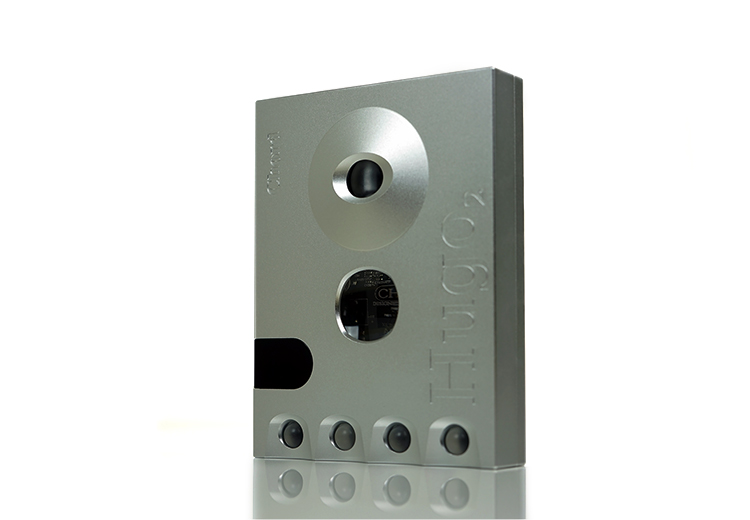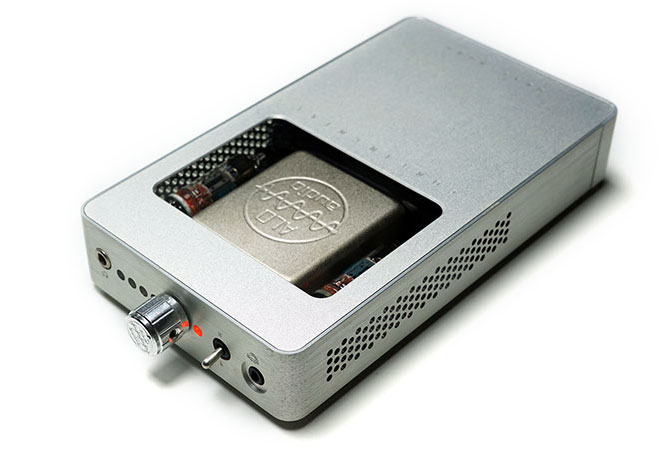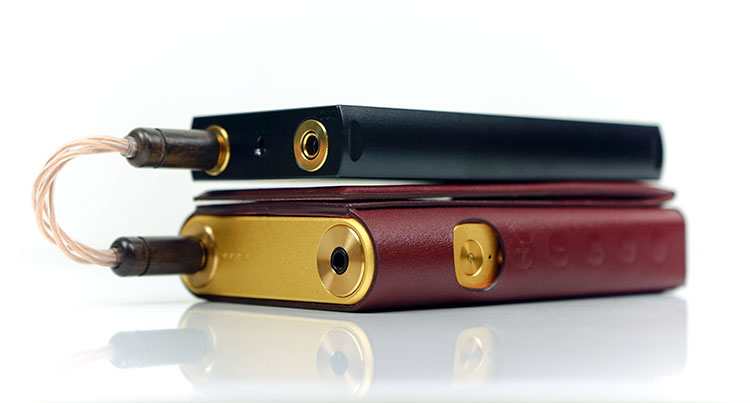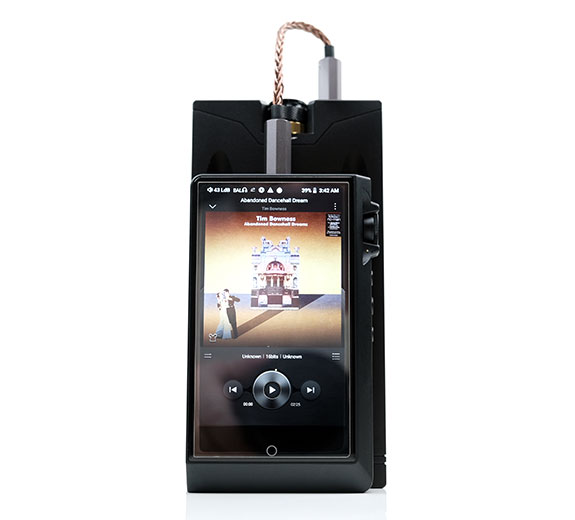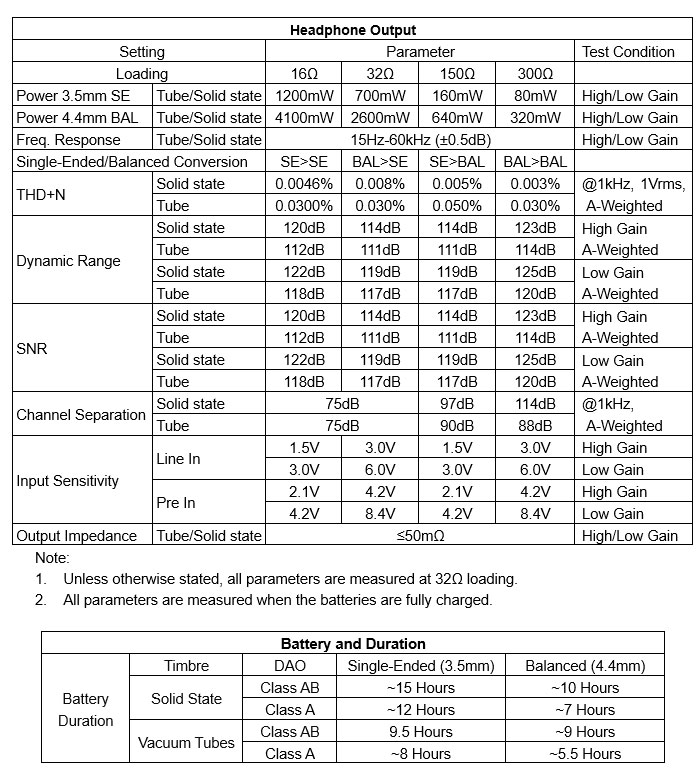Select Comparisons
(Comparisons were completed using the Cayin N6ii and E02 Motherboard as the source. Test headgear included Campfire Audio’s Andromeda 2020, qdc Dmagic 3D, Vision Ears VE8, and the Empire Ears Odin.)
Chord Electronics Hugo 2
£1,800.00 / $2495
Granted the Hugo 2’s DAC is perhaps the real talking point in its internal makeup but it is worth comparing with a source attached to judge how both amplification setups perform.
In fact, we can actually attach the Hugo 2 DAC to the C9 via its unbalanced RCA out to the 3.5mm input of the C9 to get a fairly accurate understanding of the differences between their two amp stages.
Technical
The Hugo 2 amplification is 100% solid-state and pure Class A, unlike the C9 which can give you both solid-state and tube options as well as Class A and Class A/B. You can argue though that the DAC inside the Hugo 2 with its excellent filtering system does operate in a slightly similar manner to allow for changes in the timbre.
On the single-end, at a 32Ω their output ratings are quite similar with the Hugo 2 capable of 740mW and the C9 rated at 700mW.
I suspect the Hugo 2 might have a bit more power at 16Ω going unbalanced, but Chord does not measure that. Instead, we have 1W at 8Ω for the Hugo 2 whereas we have 1.2W at 16Ω for the C9. The Hugo 2 does seem more capable though at 300Ω with a 94mW rating compared to 80mW for the C9.
Cayin does have a built-in advantage if you need more power. Going balanced on the C9 pushes the output rating up to 2.6W at 32Ω which is a big advantage over the Hugo 2’s single-ended only PO 740mW output equivalent.
In terms of distortion on the single-end, the Hugo 2on paper has the better numbers with a THD+N of <0.0001% at 300Ω compared to the C9’s best effort <0.003% in its balanced to balanced solid-state mode. However, for noise, the C9 did better on low-gain unbalanced with lower hiss levels than the Hugo 2 with sensitive IEMs such as the Andromeda 2020.
Channel separation does seem to be better on the Hugo 2 at 135dB at 1kHz 300Ω single-ended compared to a maximum of 114dB going balanced solid-state.
Design
Though both have very different design philosophies, neither are that small. Both I would class as transportable with the Hugo 2 significantly the lighter of the two at 390g compared to the C9 at 550g. However, the unique design of the Hugo 2 and slightly more compact dimensions make it the more aesthetically engaging of the two portables.
The C9 is more traditional in its layout approach with all I/O to the front panel and charging only to the rear. The Hugo 2 is a mix and match of charging and USB-DAC/OTG to the front underneath its control interface and its analog PO/LO plus its coaxial and optical interfaces to the rear.
Personally, I prefer the more orderly I/O of the C9. The Hugo 2 I/O makes it a bit of a challenge to work a headphone on one end and operate the controls on the other end. I would have preferred the Hugo 2 controls and PO/LO to be on the same side.
The control interface of the Hugo 2 orb color system is a steep learning curve and like a language, you can actually forget it if you do not regularly use it. The C9’s mechanical switching interface is much simpler and easier to understand with proper labeling.
Finally, the battery life on the single-end is better on the C9 compared to the Hugo 2 at a maximum of 15 hours using its Class AB single-ended solid-state mode. The Hugo 2 has a smaller non-replaceable 2600mAh li-poly battery, as well as DAC duties, which drops it down to around 8 hours single-ended.
Performance
Choice Stack
If you have a Hugo 2 and thinking about buying a C9, then the star of this comparison is really the Hugo 2 DAC. Combined with the C9 via its line-out (dual RCA), the dynamic range and amount of detail are just stellar.
This could be the ultimate choice stack. By choice, I mean you have the Class A solid-state amp inside the Hugo 2 but also the choice of the Class AB solid-state from the Cayin C9 or the tube timbre in both Class A and Class B. Trust me, there are differences but driven by that DAC all the possibilities sounds excellent.
Timbral differences
What are those differences? At a high level, the Hugo 2 sounds a little more linear for me both in FR bias and overall timbre being a shade more neutral.
The C9 on solid-state Class A has a weightier response at the low level, something easily picked up by even a moderately bassy monitor such as the qdc Dmagic 3D. The separation and control of the Hugo 2 bass are excellent with a bit more presence on the lower-mids and a little less bass to mids separation compared to the C9.
Again, it is that linear reference-like delivery whereas the C9, at least in solid-state opts for more weight and depth to tease out that stronger sub-bass presence.
In Class AB solid-state the bass is even more amplified over the Hugo 2 amp stage and punchier also. However, vocals have a bit more texture and detail on the Hugo 2 compared to the C9 AB/solid-state performance. Not that the C9 AB/solid-state is thin, not at all, just not as gritty and in your face.
With the tube timbre on in Class A, you do get a creamier and sweeter tone and more character, especially in vocals though the solid-state and Class AB bass weight is weaned back a little in favor of that mids presence. Here, the Hugo 2 sounds the drier of the two, a slightly shorter decay and more, well, solid-state in its vocal tone as one would expect it to be.
Staging
If you need a bit of weight and depth and maybe more bass bloom sub-200Hz then the C9 has the edge over the flatter Hugo 2. It will offer a bit more depth and tease out a stronger sub-bass response with monitors that can deliver that such as the Empire Ears Odin.
I would say though the Hugo 2 has a slightly wider staging quality backed up by more lower-mids presence with that smooth bass-to-mids transition. It has a very impressive channel separation performance for backing vocal harmonies whereas the C9 is a shade more centered in its delivery.
Further, the Hugo 2 amplifier does seem to be more aggressive in delivering midrange detail compared to the slightly relaxed sound of the C9 when in tube mode, either Class A or Class AB. The best way to describe it is leaping out at you versus presenting it to you.
Overall
Honestly, both amp stages are bringing something quite different to the table. For me, the C9, paired with the same Hugo 2 DAC, represents a different flavor and a few more choices of flavor at that.
If you want a more aggressive midrange in terms of pace, detail, and width then the Hugo 2 seems to have an edge, whereas the C9 offers a weightier low-end, a bit more sub-bass coloration, and at times a more euphonic or sweeter sounding vocal tone.
ALO Audio Continental Dual Mono (CDM)
$1495
Now, the CDM has been out for a while, around 5 years in fact, and not being actively sold anymore by ALO Audio. However, I still use it, and I know a lot out there locally would give their left arm to get one.
Like the Hugo 2, it is not just a pure amplifier but also has a DAC inside. The DAC inside is quite old, a Wolfson WM8741 that tops out at DSD64 and 24BIT/192kHz so it’s not cutting edge.
However, combined with the amplification stage I do love the tonality it can create. It is really its amp stage that people today still buy it for.
Technical
On a high level, both amps use a dual-tube design in their amplification topology with Class A and Class AB stages. However, both implementations are quite different.
The CDM uses Class A only for the tube output and Class AB is purely for the solid-stage output component. Never the twain shall meet, unlike the C9 where you can use the tube output with either Class A or Class B and the same independent switching also for the solid-state timbre.
The tube format inside each is also very different. The CDM uses a pair of New-Old-Stock 6111 Vacuum Tubes and handles the CDM’s current gain as opposed to voltage gain (solid-state duties). Whereas the C9 opts for the newer spring-loaded Korg NuTube 6P1 also in a dual array.
Both are essentially dual-triode but the NuTubes are much smaller and consume far less power than the older glass design inside the CDM.
Power Handling
Beyond timbral differences, the rated output power of the two does highlight how much more powerful the C9 actually is. At 32Ω you are only getting 80mW and 125mW balanced compared to the C9’s 700mW and 2.6W unbalanced and balanced. That is a huge difference and makes the C9 far more flexible for more demanding headphones.
At 300Ω, the gap is a bit closer at 80mW single-ended for the C9 and 60mW for the CDM unbalanced but at balanced the C9 is much better equipped for high impedance headphones at 320mW compared to just 95mW from the CDM.
If you think, well ok then, the CDM is much better for handling IEMs, that might be true on a pure power rating basis, however, its noise floor is a lot higher than the C9, at least in our real-world testing with sensitive IEMs. Channel balancing is also quite dodgy at low volume levels with the CDM compared to the C9 using sensitive gear.
Design
Hand on heart I love the CDM aesthetics with its retro curved aluminum chassis, venting to the sides, and that Gorilla Glass portal at the top to allow for maximum tube glow.
It is a classic for me and whilst the C9 feels the more solid, dissipates heat much better, (the CDM gets very hot), it does look a little subdued in comparison. It is also the bigger and heavier of the two.
However, the CDM design does have some operational flaws, namely socket spacing and it is one of the reasons why I mentioned good spacing on page 1 during my design description.
The CDM sockets are incredibly close to each other on the rear panel, especially the power and line out and it does make it a bit of a challenge to both charge or power via its supplied power cable and line-out to the desired amplifier, especially if you use big jack barrels.
To make matters worse, the older micro-USB socket is way too close also to the power socket so everything feels kind of jammed in there. Switches are thankfully stem-type rather than sliders, but the space is not easy when you have a bunch of cables in the rear and often heavier cables can unbalance the CDM from whatever it is sitting on.
Finally, the CDM does have balanced and unbalanced inputs and outputs (PO/LO) but they are the older 2.5mm TRRS type and not the newer and more stable 4.4mm balanced connection.
Technical Performance
I think the first noticeable difference between these two is not so much the timbral variation but rather the technical side of things. If you are using sensitive IEM’s and going balanced both will display a level of hiss but the CDM is far higher to the point where it can interfere with the dynamic range and level of noticeable micro-detail.
You get a sense that the CDM is every bit as lively but it’s more of a blob or a rush of excitement than the separation and refinement of each note when pairing something like the Andromeda 2020 or Vision Ears VE8 with the C9.
Using balanced 4.4mm all the way from source, (Cayin N6ii/E02) to IEMs, the C9’s dynamic range is just that bit more convincing with its blacker background and clearer instrumental separation.
And I say that going through all 4 Class/Timbre modes but particularly in tube Class AB since that is the same base topology as the CDM’s amp. Simply, put, the C9 sounds the more resolving of the two amps using a line-in.
Timbral Differences
On the timbral side, there is a slight difference between the two tube stages. With the tube on Class AB, the C9 sound is a little more weighted, rounded, and not as forward on the treble. The CDM is very lively through the mids and treble but has more of an upper mids focus and a forward vocal presence.
That affects a lot of voicing between the two amps. Soulful chesty vocals have a stronger base and broader texture on the C9. The CDM seems to drop a little bass weight and lightens the tone so more mid and treble overtones creep in. One can argue a sweeter tone on the CDM compared to a richer sound on the C9.
You can reduce the level of bass and push the vocals further forward though using Class A on the C9, particularly when combined with the tube timbre. Here the C9 can take the CDM on at its own game and beat it handily because of the mids to treble timbral balance.
The reason for that last statement is the treble refinement. The CDM treble is a little rough around the edges compared to the C9, even when I move to a cooler solid-state Class AB and not just in tube mode. You get a tinge of hardness in vocals and mids instrumental timbre that is not there on the C9. The C9 treble is more liquid for me and the timbre is smoother as a result.
Oriolus BA300S
$415
This is a much cheaper balanced tube amplifier option than the C9. However, it is worth dropping in a quick comparison for those that own it and wonder if the C9 is a worthy upgrade.
Technical
Of course, the BA300S amplification is much more limited in ambition with a single current-mode opamp diffused output and a set of micro-tubes.
It does not have any DAO or the ability to switch timbre so its tonality is fixed or only affected by whatever source you connect it with. It does not have a gain switch nor can it act as a pre-amp to your headphones though it can take a line-in from any compatible source.
It does, however, have a fully balanced 4.4mm PO much like the C9 though no 3.5mm TRS equivalent PO and LO that the C9 has. Oriolus has supplied 3.5mm to 4.4mm IC cables to get around that impasse.
There is no volume control on the BA300S, instead is controlled via your source so basically, you are double-amping as opposed to receiving a pure line-out signal which the C9 can offer.
Power
In terms of rated output power, no contest with a maximum of 500mW at a 32Ω balanced compared to 2.6W on the same load from the C9’s equivalent balanced output. The BA300S pitch was always intended to pair closely with Sony DAP users so 500MW is a huge jump for the likes of the 1Z but if you are looking for a lot more then the C9 will offer that.
The distortion levels of the tube amp inside the BA300S are quite competitive though with a THD+N of 0.02% which is a little lower than the C9’s 0.03% for its tube design in all operational modes both balanced and unbalanced.
However, you do have to balance that with the distinctly lower level of power the BA300S generates. If you switch to solid-state for the C9 it can go a lot lower also at 0.0046%.
Finally, the noise floor on the BA300S is nowhere near as elegantly reduced as the C9. If you are using sensitive IEMs with balanced connections the BA300s has a lot more hiss than the C9 in its equivalent balanced output.
Design
This is where the BA300S has a distinct advantage if a pure portable tube amp is your end-goal. It is much smaller, more compact, and lighter. The BA300S is really designed to stack on the go whereas the C9 is a transportable device and almost a small desktop solution.
Neither have flash designs with both all in black and the BA300S offering a small window for the tube glow much like the two portholes on the C9 for its green NuTubes to shine.
Of course, the BA300S has a very simple aim and that’s to boost the signal of a Sony DAP or similarly spec’ed sources. It has little in the way of onboard functionality and therefore little requirement for additional interfacings such as volume, line-out, pre-amp, or unbalanced connections.
The C9 may be bigger but it is much more comprehensive in its functionality and not just an upgrade but an almost different user scenario. It does much more than simply stacking on a DAP.
Performance
I switched to the less efficient Empire Ears Odin for this one because the noise floor on the BA300S with the VE8 and Andromeda was unbearable for hiss. Whilst not a black background, it did fare a lot better whereas on the C9 it was completely quiet and much the better for it.
The broad thrust of this comparison is a little like the CDM with the technicalities shining through very quickly in terms of which is better. The BA300S is more intimate sounding and for the Odin that might not be the ideal synergy.
You want that double dynamic driver sub-bass response to shine and it just didn’t with our N6ii/E02 combo compared to the C9. Instead, it rolled off a little so you got a nice rich timbre, excellent mid-bass punch, and warmth but not the rumble nor the expansive soundstage.
With the C9, not only was the sub-bass gravitas restored but also the resolution of the sub-bass texture shone through. It simply sounded tighter, clearer and as a result, the music sounded more interesting and engaging.
That might well be a dynamic range gap also because the timbre on the BA300S was euphonic, creamy, and broad and really endeared itself to vocals. However, I did not get a complete sense of what was happening around the vocals or beyond the mid-bass punch. It felt a little compressed at both ends of the spectrum with more of a mids focus.
The C9 just sounds bigger, more 3-dimensional, and with the Class AB mode turned on, much better for depth and power also.
Our Verdict
The Cayin C9 is the company’s most refined version yet of their DOA and timbre technology inside their portable audio gear. Not only that, but it also revitalizes tubes on the go, a traditional niche in our hobby that seems to be forgotten in the head-long rush to find that one DAP on steroids.
Granted it is big, heavier than a DAP, and more on the transportable side but DAPs cannot do what the C9 does, at least not yet. I would also consider it a potential desktop amp replacement given its power.
It can PRE-amp out of a desktop DAC and pack enough power to handle most headphones easily. Yet, at the same time deliver an impeccable black background for almost all gear bar the most sensitive on its balanced output. And with tubes, real tubes, and a sound that stays true to that tube sound.
Replaceable batteries, easily obtainable and relatively cheap 18650’s at that, is also a clever move. That should keep the C9 chugging along quite happily for years without any concerns other than gradual wear and tear of the components inside.
After all, this is a pure amp so the product life cycle here should be very long. Some of my best analog gear or amps are years old and still sounds excellent today if well looked after. I cannot see how the Cayin C9 will be any different.


